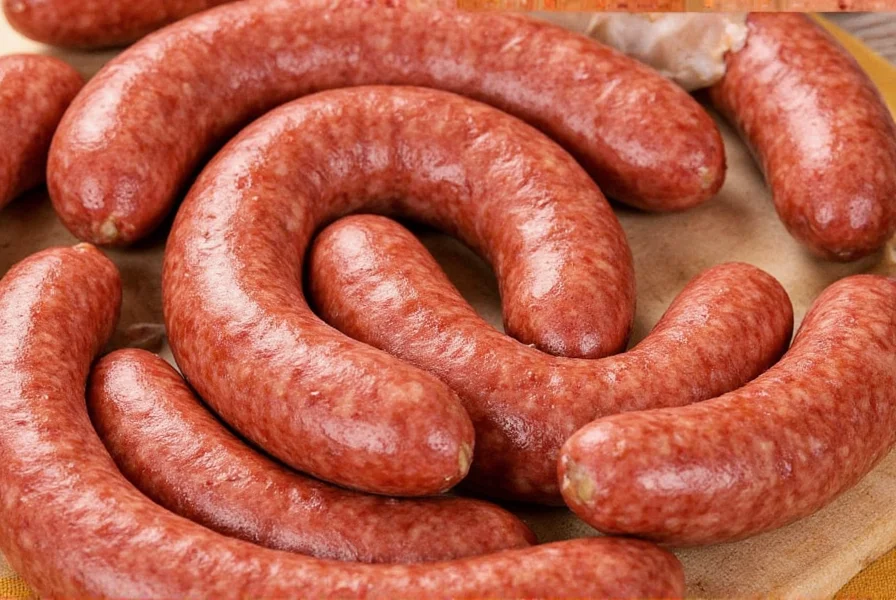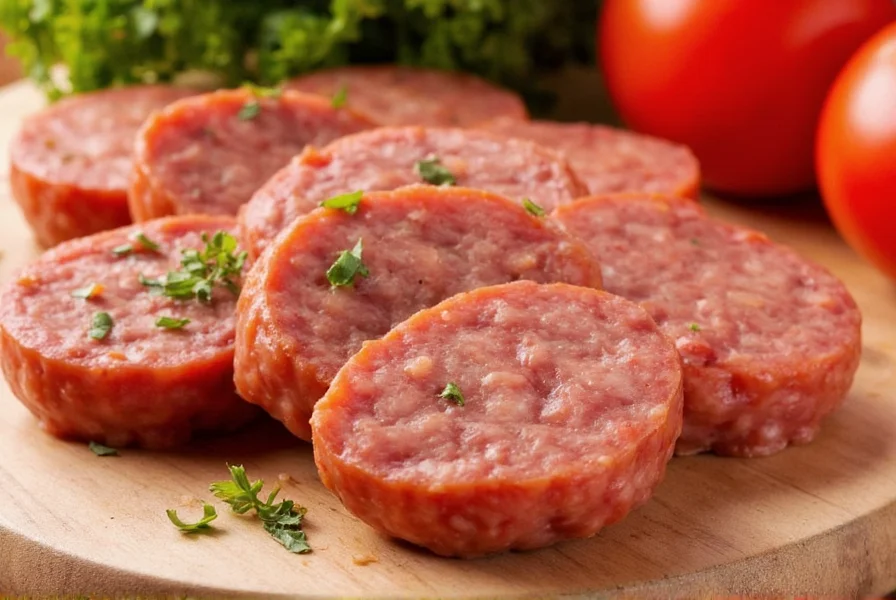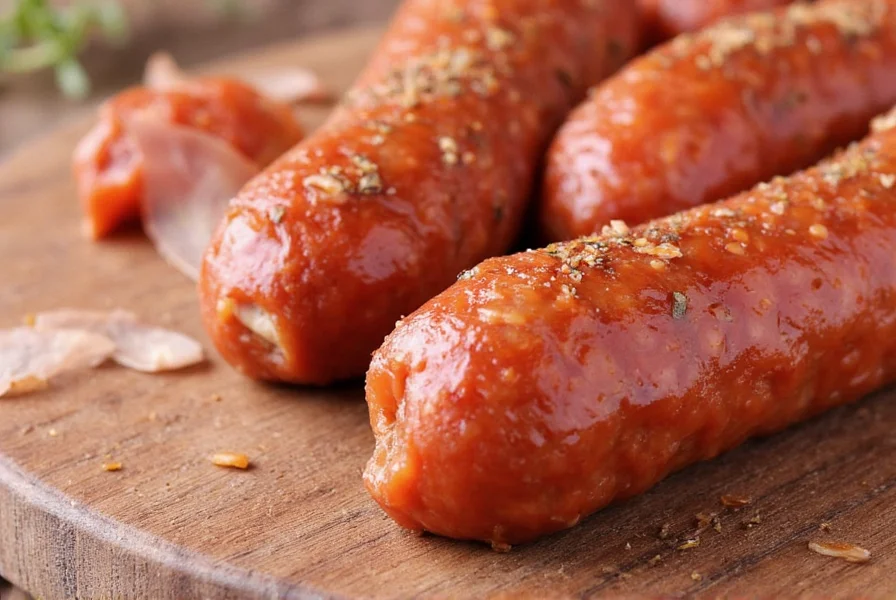Italian sausage contains six essential seasonings that create its distinctive flavor profile: fennel seed (the signature ingredient providing a sweet, licorice-like note), garlic (for aromatic depth), salt (for flavor enhancement and texture), black pepper (for subtle heat), red pepper flakes (in spicy varieties), and often additional herbs like oregano or basil. These seasonings work together to create the characteristic taste that distinguishes Italian sausage from other varieties.
| Core Seasoning | Flavor Contribution | Typical Amount per Pound |
|---|---|---|
| Fennel Seed | Signature sweet-anise flavor | 1–2 tbsp |
| Garlic | Pungent, aromatic backbone | 2–4 cloves |
| Salt | Flavor enhancer and texture binder | 1 tsp |
| Black Pepper | Mild spiciness and complexity | ½–1 tsp |
| Red Pepper Flakes | Spicy kick (in hot varieties) | ¼–1 tsp |
The Science Behind Italian Sausage's Distinctive Flavor
What gives Italian sausage its unique taste? The magic lies in the precise balance of these seasonings, particularly the fennel seed which contains anethole—the same compound found in anise and star anise. This creates that distinctive sweet, slightly herbal note that defines authentic Italian sausage.

Breaking Down the Essential Seasonings
1. Fennel Seed – The Defining Ingredient
Fennel seed isn't just common in Italian sausage—it's the ingredient that makes it authentically "Italian." Without fennel, you'd have a different type of sausage altogether.

- Chemical Composition: Contains 70-90% anethole, giving that characteristic licorice note
- Optimal Usage: Toast seeds lightly before grinding to release maximum flavor compounds
- Regional Variations: Northern Italian recipes often use less fennel than Southern varieties
2. Garlic – The Flavor Foundation
Garlic provides the savory backbone that complements fennel's sweetness. The preparation method significantly impacts flavor intensity:
- Fresh vs. Powdered: Fresh garlic delivers bold, pungent notes while powder offers more uniform distribution
- Enzyme Activation: Crushing garlic releases alliinase enzyme, creating more complex flavor compounds
- Heat Sensitivity: Allicin (garlic's primary compound) breaks down at high temperatures, so add near end of cooking for strongest flavor
3. Salt – More Than Just Seasoning
Salt serves multiple critical functions in sausage making:
- Protein Extraction: Draws out myosin proteins that help bind fat and create emulsion
- Microbial Control: Inhibits harmful bacteria growth during curing
- Texture Enhancement: Creates the characteristic firm yet juicy texture of quality sausage
4. Black Pepper – Complexity Without Overpowering
Black pepper adds subtle heat that complements rather than competes with fennel:
- Piperine Content: The active compound providing heat (5-9% in black pepper)
- Optimal Grinding: Whole peppercorns ground just before mixing preserve volatile oils
- Synergy: Works with fennel to create a flavor profile greater than the sum of its parts
5. Red Pepper Flakes – The Spicy Differentiator
The key distinction between mild and spicy Italian sausage:
- Capsaicin Levels: Typically 0.1-0.5% in standard red pepper flakes
- Regional Influence: Reflects Southern Italian preference for more heat
- Bloom Technique: For maximum heat distribution, toast flakes in oil before adding to meat
| Characteristic | Mild Italian Sausage | Spicy Italian Sausage |
|---|---|---|
| Primary Spice Profile | Fennel-forward with subtle garlic notes | Fennel balanced with noticeable heat |
| Red Pepper Content | None or trace amounts (<1/16 tsp/lb) | 1/4-1 tsp per pound of meat |
| Traditional Regions | Northern Italy (Tuscany, Lombardy) | Southern Italy (Calabria, Sicily) |
| Ideal Cooking Methods | Pan-searing, baking, grilling | Grilling, braising, high-heat methods |
Why These Specific Seasonings? The Historical Context
Italian sausage seasoning isn't arbitrary—it evolved from practical preservation needs and regional availability. Before refrigeration, these specific spices served multiple purposes:
- Antimicrobial Properties: Garlic and certain spices naturally inhibited bacterial growth
- Flavor Masking: Strong spices masked off-flavors in less-than-fresh meat
- Regional Adaptation: Each Italian region developed variations based on locally available spices
Precision Measurements for Perfect Homemade Italian Sausage
Professional butchers use exact ratios to achieve consistent flavor. Here's the precise formulation used by Italian-American specialty butchers:

Exact Proportions per 5 Pounds of Pork Shoulder
- Fennel seed: 5-7 tablespoons (toasted and coarsely ground)
- Fresh garlic: 10-15 cloves (minced fine)
- Kosher salt: 5 teaspoons (not table salt)
- Freshly ground black pepper: 2.5-5 teaspoons
- Red pepper flakes: 0-2.5 teaspoons (depending on heat preference)
- Cold water or ice: 1/4 cup (helps with emulsion)
Critical Technique Notes
- Temperature Control: Keep meat below 40°F during mixing to prevent fat smearing
- Mixing Duration: 2-3 minutes by hand or 45-60 seconds in mixer for proper bind
- Resting Period: Minimum 12 hours in refrigerator before cooking for flavor development
| Brand | Seasoning Analysis | Authenticity Rating |
|---|---|---|
| Jimmy Dean Premium | Fennel (1.8%), garlic powder (0.7%), red pepper (0.3%) | 7/10 (Good fennel level, slightly high preservatives) |
| Hormel Fire-Braised | Fennel (1.2%), garlic powder (0.4%), red pepper (0.5%) | 6/10 (Low fennel, high sodium content) |
| Applegate Farms Organic | Fennel (2.1%), garlic (1.0%), red pepper (0.2%) | 9/10 (Highest fennel content, no artificial ingredients) |
Advanced Flavor Pairing Techniques
Professional chefs maximize Italian sausage's potential through strategic flavor pairings that complement its seasoning profile:

- Sweet Counterbalance: Pair with caramelized onions or roasted peppers to complement fennel's sweetness
- Aromatic Enhancement: Deglaze pan with fennel fronds-infused broth to double down on the primary flavor
- Texture Contrast: Serve with creamy polenta to balance the sausage's firm texture
- Acid Balance: Finish with lemon zest to cut through the richness without overpowering spices
Frequently Asked Questions About Italian Sausage Seasonings
What are the essential seasonings in traditional Italian sausage?
The six essential seasonings in traditional Italian sausage are fennel seed, garlic, salt, black pepper, red pepper flakes (for spicy version), and sometimes additional herbs like oregano or basil. Fennel seed is considered the signature ingredient that gives Italian sausage its distinctive flavor profile. Authentic Italian sausage must contain fennel—without it, you're making a different type of sausage altogether.
Why does Italian sausage have a licorice-like flavor?
The characteristic licorice-like flavor in Italian sausage comes primarily from fennel seeds. Fennel contains anethole (70-90% of its essential oil content), the same compound found in anise and star anise, which gives it that distinctive sweet, slightly herbal note. This is what sets Italian sausage apart from other sausage varieties. The concentration of anethole in fennel creates a flavor profile that's unmistakably "Italian" when properly balanced with the other seasonings.
What's the precise difference between mild and spicy Italian sausage?
The scientific difference lies in the capsaicin content from red pepper flakes. Mild Italian sausage contains no red pepper flakes or only trace amounts (<1/16 teaspoon per pound), resulting in a Scoville heat unit (SHU) rating of 0-50. Authentic spicy Italian sausage contains 1/4 to 1 teaspoon of red pepper flakes per pound, giving it 500-2,500 SHU. Both varieties contain identical base seasonings (fennel, garlic, salt, pepper), but spicy versions have added capsaicinoids that activate TRPV1 receptors, creating the sensation of heat while maintaining the fundamental Italian sausage flavor profile.
Can authentic Italian sausage be made without fennel?
No, authentic Italian sausage cannot be made without fennel. Fennel seed is the defining characteristic that differentiates Italian sausage from other varieties like bratwurst, chorizo, or breakfast sausage. According to Italian culinary tradition and USDA standards for "Italian" labeled sausage, fennel must be the predominant spice. Without fennel's anethole content creating that signature flavor profile, you're making a different product that should not be labeled as Italian sausage. Some regional Italian varieties use less fennel, but it's always present as the primary seasoning.
How do professional butchers achieve consistent seasoning in Italian sausage?
Professional butchers use precise weight-based measurements rather than volume measurements for consistent results. They measure seasonings to 0.1% precision by weight of the total meat mixture. For example, authentic Italian sausage contains 1.5-2.5% fennel by total weight, 0.5-1.0% garlic, and 2.0-2.5% salt. They also toast and grind fennel seeds immediately before use to maximize volatile oil retention, and use calibrated meat mixers that operate at specific temperatures (34-38°F) to prevent fat smearing while ensuring even seasoning distribution throughout the emulsion.
What scientific principle explains why Italian sausage seasonings work so well together?
The flavor harmony in Italian sausage follows the scientific principle of flavor layering and molecular compatibility. Fennel's anethole molecules interact favorably with garlic's allicin compounds through hydrophobic interactions, creating a more complex flavor profile than either would alone. Salt enhances umami perception by activating TAS1R receptors, while black pepper's piperine increases absorption of other flavor compounds. This creates a synergistic effect where the total flavor impact exceeds the sum of individual components—a phenomenon food scientists call "flavor potentiation." The specific ratios used in traditional recipes have been refined over centuries to maximize this chemical synergy.











 浙公网安备
33010002000092号
浙公网安备
33010002000092号 浙B2-20120091-4
浙B2-20120091-4